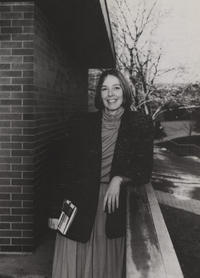How I Shaped WLUP’s List to Include New Voices
From WLU Press' Director and Senior Editor, 1983-1999
I grew up at a time when children were to be seen and not heard. Even as a child I knew that women didn’t have much voice either. So, it’s not surprising that, as editor of WLU Press, I was sensitive to the fact that most academic books were written by men and were about other men who had played a role in Western history and culture. The experiences of women, children, Indigenous Canadians, immigrants, and even ordinary working men were generally missing and I increasingly wanted to know what they had been thinking and doing. What were their contributions?
Edna Staebler was a well-known author in her eighties who came up to me at the end of an event and said she wanted to get to know me. “You can actually say that to people!” I thought. Revelation. “Give me a call,” she said. I visited her on a Friday afternoon in June and came away with her edited collection of letters written by her sister Ruby, a housewife with two children. I stressed to Edna that we published scholarly books but at her insistence the manuscript came home with me.
I had two academic manuscripts to read that weekend. I wasn’t terribly impressed with either of them, so on Sunday afternoon I decided to see what Ruby’s letters were all about. I was immediately hooked. Social history was unfolding through the experiences of Ruby’s family. But how could a university press publish a housewife’s letters?
I remembered that I had read a couple of articles by Marlene Kadar of York University, one of which was about Kahlo’s letters to Trotsky. Would she think a housewife’s letters worth publishing? We talked on the phone and arranged to meet in Toronto to explore the idea of publishing life writing texts. We decided on a series of works by people who had written letters, diaries, journals, or memoirs with no literary intent. A foreword by an academic in the relatively new field of life writing would make the texts useful to scholars and students. The broader public might find them interesting too. Marlene agreed to be the series editor.
Haven’t Any News: Ruby’s Letters from the Fifties, edited by Edna Staebler, with a foreword by Marlene, became the first book in the Life Writing series. Ruby had given her permission and enjoyed the book launch.
I am so glad that the series continues to flourish and bring forth voices that would otherwise remain unheard. My regret as editor was having to reject manuscripts, some of which I think of to this day, that I couldn’t convince myself were financially viable publishing projects. A few of those I arranged to be archived in the university library. I might add that our history will continue to be incomplete as long as archives privilege the records of prominent people.
It was striking to me that people generally wrote most powerfully when they wrote about their early childhood. Some works in the Life Writing series were clearly rich sources on childhood and family life, an area of history in which we had not previously published. When I became acquainted with the work of Cynthia Comacchio and Neil Sutherland, we began the Studies on Childhood and Family in Canada series with Cynthia as editor. Now the Press is about to publish Ring Around the Maple, a massive work by the two of them on the condition of children in Canada from about 1850 to 2000. I can hardly wait to read it.
In 1974, I worked with people from Chippewa, Oneida, and Muncy First Nations recreating a Neutral village. That was when I learned that our government forced Indigenous families on reserves to destroy their old house if they built a new one. This had prompted these three Nations to each donate their chief’s log cabin to the local Conservation Authority. I lived in the Oneida cabin and operated it on weekends, which were my days off, as a museum displaying Neutral artefacts. This museum activity allowed me to meet even more Indigenous people. Two Oneida men, Wes Smith and Max Ireland, were particularly generous in sharing their knowledge, personal stories and concerns for their people. Wes was able to tell me how the cabin had been furnished and what the landscape was like around it. I heard about children being beaten at residential school for calling a sister or brother by their Indigenous name. I sought authors who could help set the record straight. D.N. Sprague’s book, Canada and the Métis, 1869–1885, was the first. A co-published book on Louis Riel appeared about the same time. Stelio Cro’s book, The Noble Savage, showed how thinkers like Montaigne had been influenced by their perceptions of Indigenous peoples. As far as I know those authors were members of the settler society, a term of identity that was not in use then. David McNab (Métis) brought his insights into the colonialism of land treaties as well as the support of the Walpole Island First Nation. It was a privilege to work with them and to launch his books there. Our early titles were a first step, with greater numbers of Indigenous-authored works following.
It’s gratifying to see that 25 years after my retirement WLUP continues to publish voices that were traditionally excluded by the academy.
